#buggy projecting during the entire episode
Text
One Piece spoiler!
I'm probably reaching here, but I dare you to tell me this wasn't Buggy talking to Shanks (not that surprising after watching him having a mental breakdown while screaming at his hat, tbh):


"You're just a sad, lonely little boy wearing another man's hat". Sorry, sweetheart, but Luffy is neither sad nor lonely in that scene, you may be thinking of somebody else and the last time you saw him, just after losing someone dear to you both and being left all alone to fend for yourselves. Just saying. Plus, the spite in "the one piece will never be yours", tell him, king, that man is a fraud.
#buggy#shanks#one piece#spoilers#opla#one piece live action#akagami no shanks#red haired shanks#buggy the clown#one piece spoilers#op spoilers#these two and their break up under the rain#will never get over this#buggy projecting during the entire episode#seriously#that man was either talking to himself or his ex best friend brother lover or whatever they have going on for the entire episode#like he only really talked to luffy a couple of times#projection is strong with this one#for real#my baby really can't get over his divorce with the snitch#i love shanks btw#this is just for fun#they're both my favourite characters and shanks my baby too
53 notes
·
View notes
Text
People I wanna know better tag meme
Tagged by the lovely @syrena-del-mar!
who already knows me very well and i'm punching the next time i see her
Last song?
i got a cd player for christmas so i'm currently just going through all my cds and happen to be listening to my one jonas brothers cd that i have that i got for free when i saw them back in 2019
Favorite color?
i've always preferred to nature related colors (except my purple girly phase). i constantly cycle between green, blue, and yellow and right now i've been obsessed with shades of blue.
Currently watching?
seriously watching: hospital playlist. i prefer watching shows in their original language so i'm watching the subbed version. because i can't multitask (except that time i helped my brother stuff gyoza while watching an episode) i have to sit and pay attention to watch. but i love medical dramas and the storylines, omg. i'm only on episode 5 but i'm in love
casual watching: one piece. i'm only watching the dubbed version because there are too many episodes and i can only sit still for so long. but i'm currently more than halfway through the impel down arc. and my boys buggy, ace, sanji, and zorro have my entire heart
Last movie?
streamed: bitconned on netflix. it was during my monthly true crime binge and i went through murder and decided to end it with good old fashion schemes to end the night
in theaters: i went with my brother to go see the beekeepr with my brother last week. it was the stupidest fucking movie istg. i'm so mad we wasted our gift cards on that. it was only $14 for tickets but still. he wanted to see it because it was stupid. i'm just mad they brought my boy josh hutcherson into that train wreck during his renaissance. jason statham, you are better than this.
Sweet/Spicy/Savory?
i like spicy food a lot. love it. had to learn to love it since my mom would just dump spice in everything without adjusting. but i prefer spicy and savory over sweet. i don't like things that are too sweet. i bake a lot but don't really eat much of it.
Relationship status?
pathetically single. i've been single the entire 24 years i've plagued this earth. not from a lack of trying. just nobody, that i know of for certain, has ever been interested in me.
Current obsessions?
hospital playlist and this goddamn fic that i spent like 6 hours talking to roo about. i bought a notebook for the fic and everything. going to seriously plot it out and everything.
Last thing you googled?
"did hook die at the end of peter pan"
i took a brief detour from writing chapter 15 of my current fic to do some research for my new pet project and landed here
Selfie or another pic you took?


2 for one special. here's a picture i took at the aquarium back in 2017 and the edited version of it that i did in college. it's my favorite picture that i've ever taken omg. i love jellyfish. they're so beautiful
Tagging: @amyyscorner @ashitshowforalot @kangaracharacha @tfshouldidohere @hyuuukais @puppysmileseungmin @itshannjisung @kai-lee08
41 notes
·
View notes
Video
(NYCLU on twitter, link to video) (alt. source)


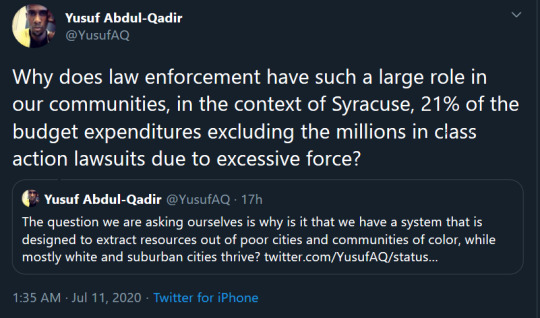
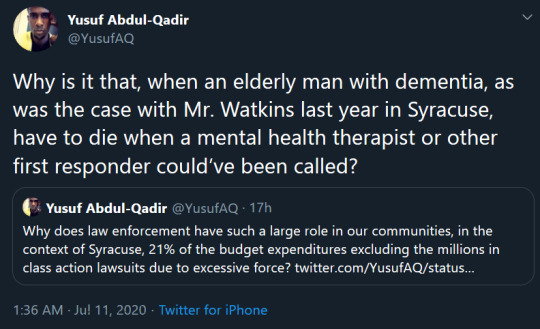
On Mr. Watkins
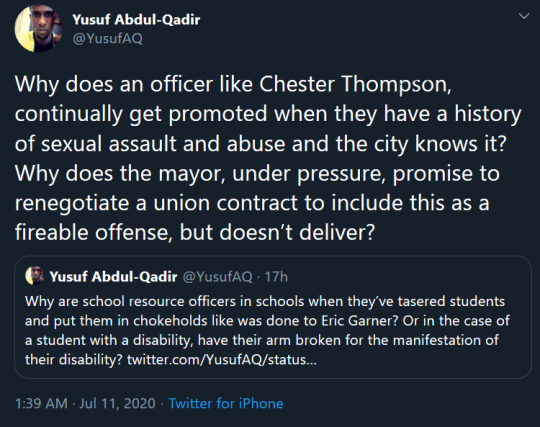
As bosses did little, Syracuse cop coerced women for sex, they say; ‘I was terrified’
Ex-Syracuse cop who had sex on the job ‘doesn’t yet want to plead’ in tampering case, ADA says
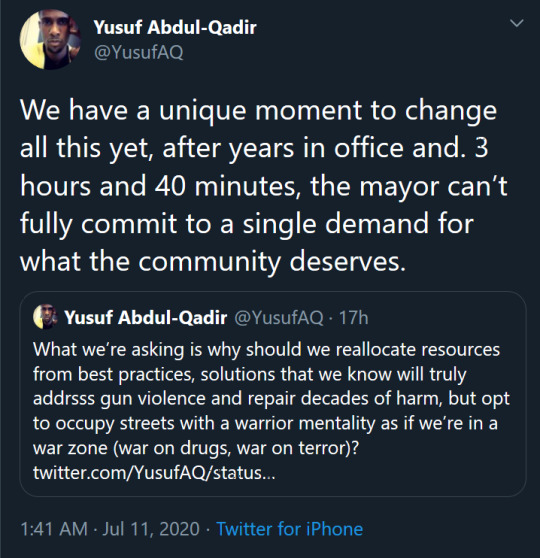


Activists hammer Walsh with demands, frustrations in marathon police reform meeting
The meeting took place almost exactly a year after a similar episode at St. Lucy’s Catholic Church. Advocates — many of whom were at City Hall Thursday — unloaded frustrations and stories of police brutality to Walsh and Buckner at that meeting, following the violent 2019 arrest of Shaolin Moore on Grace Street.
Moore was dragged from his car and punched during a stop for loud music. Buckner deemed the use of force appropriate, drawing backlash from some in the community.
Thursday, several speakers referred to that 2019 meeting. Andrew Croom, an attorney with Legal Services of Central New York, said he presented a 17-page document to the mayor at that meeting detailing well-researched changes needed to the department’s use of force policy.
After a year, he said, there had been no follow-up on that.
“For the past year you’ve talked about the use of force policy,” Croom said. “But when we show you it’s not enough, nothing happens.”
The department revised its use of force policy last spring, but activists say it still needs to improve to include language about protecting human life.
Yusuf Abdul-Qadir, director of the local chapter of the New York Civil Liberties Union, led the meeting. He spoke before and after each attendee and often challenged or corrected the mayor and the police chief.
Speaking for the groups, he demanded radical change to overhaul the police force — an institution he said evolved out of white supremacy. “Business as usual is over,” he said.
Abdul-Qadir promised that activists would not ease the pressure they’re exerting, nor would they stop protesting until significant change is evident. The desired changes include cutting millions of dollars from the police department’s annual budget and forcing officers to live in the city.
The annual budget for police is $49.5 million, which is about 20% of the city’s $253 million overall budget.

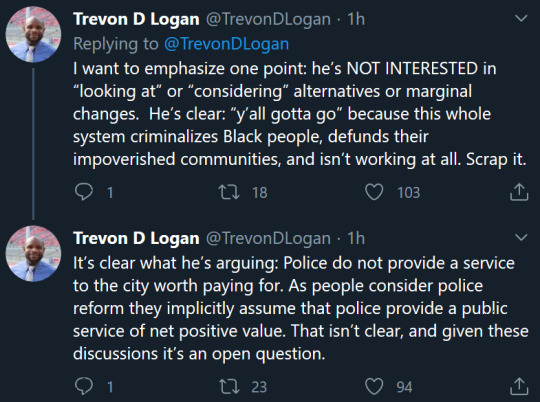
(Trevon Logan)

(Asher Vollmer)

(source)
…
Me:
Syracuse is in dire, dire straits, and it’s solely due to failed leadership, City, County, and State. Just absolute zero fucks.
No one in charge in Syracuse, from cops to the water department to DPW to the Mayor’s Office to the Onondaga County Legislature, no one in charge gives a single fuck about Syracuse or the people that live there. A few examples:
Lead paint is a problem in Syracuse. STILL.
Look what Syracuse Fire Department did back in 2017.
The Syracuse Citizens Review Board struggles to do its job.
The Syracuse PBA is just as you’d expect.
Here’s a brief summary of the 2010′s in Syracuse. Here’s another one. Remember the Syracuse Billion proposal to rebuild the collapsing water system in Syracuse? Never went anywhere. No progress with Mayor Walsh, seen being scolded in the video above.
Yes, the surrounding tony suburbs are all racist as fuck. Many people that work in Syracuse (and for Syracuse) live OUTSIDE Syracuse, and the argument that Syracuse’s municipal payroll props up the ‘burbs is a good one. Sure, the argument already seems to be “iTs A dRoP iN tHe BuCkEt” yet imagine what this is like in bigger cities, like NYC?
Don’t get me started on Interstate 81. (The mega-project has stalled.)
There’s this reddit thread…

Finally, read this...
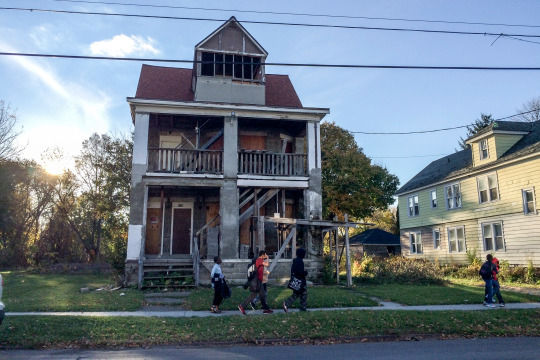
The Atlantic: How to Decimate a City (Nov. 2015)
Neighborhoods like this one, in the south part of Syracuse, have historically been poor, but residents here say they’ve seen things worsen in the last decade. Darlene Sanford, 38, runs a daycare in her great-grandmother’s spacious 19th-century house near the highway. Sanford remembers walking to the black-owned small businesses that lined the streets here when she was a girl, but most of them have disappeared.
Although most of the houses on Sanford’s street have well-mowed lawns and manicured bushes, she now feels a sense of unease. A few weeks ago, she had to call 911 after a man living next door was targeted in a drive-by shooting, just after Sanford had put the younger kids in her care down for a nap. She no longer leaves her house at night. She’s thinking of leaving the city entirely.
“Over the last few years, it’s been pretty tough,” she said. “The violence has gotten worse.”
The week before I visited Syracuse, seven people had been shot in four days, including a public-bus driver whose cell phone blocked the bullet.
“We see a lot of generational poverty here,” Rebecca Heberle, who runs the local Head Start program for PEACE Inc., a nonprofit in Syracuse, told me. “People face so many challenges—their power has been turned off, they have infestations, they need money for food, formula, diapers, a bus pass.”
It wasn’t always this way.
Search for Syracuse in the rankings of cities with the highest poverty rates in America, and the city has moved up every 10 years like an underdog racehorse gaining on the winner (or in this case, the loser). In 1969, the city’s poverty rank was 72nd in the nation of cities with a population of 100,000 or more, with 14 percent of its residents living in poverty. By 1979, it had snuck up to 44th, with a poverty rate of 18 percent. By 1989, it was tied for 26th with a poverty rate of 23 percent.
The story of how poverty became one of the defining characteristics of Syracuse is specific to the city and the region, but in some ways it is illustrative of the many policy decisions that have made all American cities more segregated by race and income over the last 15 years.
Like many cities in the north, Syracuse became home to a growing African American community in the post-World War II years, as migrants fled persecution in the South and came north looking for jobs.
Many settled in the 15th Ward, a neighborhood adjacent to downtown. Clarence “Junie” Dunham, who is now 81, lived there in an apartment with no hot water, at a time when a milkman still delivered bottles from a horse and buggy. Dunham’s parents and their friends had moved to town from the south, and many had little beyond a middle school education, but they worked in the factories and farms in the region and made a good enough living. There was poverty then, he told me, but he remembers that time fondly, largely due to the existence of a close-knit black community that socialized around Wilson Park, a square of green grass and trees in the center of town.
But to outsiders the majority-black neighborhood was “slum land,” ripe for redevelopment because of its proximity to downtown, according to Joseph F. DiMento, who was born and grew up in Syracuse and is now a professor of law, planning, and policy at the University of California-Irvine School of law.
In the early 1950s, a small group of builders proposed that the city obtain “slum land,” clear it, and get it ready for development—for private industry to do so would be too costly, they said, according to DiMento, who authored a paper on so-called urban renewal in Syracuse. “Racial barriers have created an overcrowded condition that many experts felt may some day lead to troubles,” The Syracuse Post-Standard wrote in an article in 1954.
At the same time, the city was working to get a piece of some of the money made available in the 1956 Federal Highway Act, which authorized money for the construction of the Interstate system.
A strong highway network, city leaders argued, would make Syracuse one of the largest cities in the country because people would be able to easily commute to downtown from outlying areas. In 1956 the state approved a $500 million bond for a project that would raze the 15th Ward and erect an elevated freeway that bisected downtown. That this construction would destroy a close-knit black community, with a freeway running through the heart of town, essentially separating Syracuse in two, did not seem of much concern to local leaders.
They wanted state and federal funding, and were willing to follow whatever plans were proposed to get it. “The city was almost unimaginably passive about these decisions,” DiMento told me.
“Rather than fostering a sense of neighborhoods, city officials viewed distinctive city sections as expendable or blighted areas needing to be razed,” DiMento wrote in his study of the construction of I-81 in Syracuse.
Today, I-81 runs north to south through the city; its most prominent part is a 1.4 mile section of elevated highway that separates Syracuse University from downtown and the city’s high-poverty South Side. Underneath the elevated highway, the streets are dark and clogged with cars trying to get on the road, and next to it are some of the poorest neighborhoods in the city.
It runs over Wilson Park, the place Dunham used to play as a child, and over the blocks where he and his childhood friend Manny Breland used to collect scraps to take to the junkyard for extra money. “That’s where I used to live,” Breland told me, pointing to a stairway in a parking garage that abuts the freeway.
#syracuse ny#nyclu#aclu#yusuf abdul-qadir#syracuse#mayor ben walsh#ben walsh#black lives matter#us police crisis#us law enforcement#blm#new york state#nys#news#Syracuse#rust belt#defund the fucking police#defund the police#abolish the police#public safety reform#us poverty#america 2020#long rant
0 notes
Text
Asunción, Paraguay’s, hadn’t impressed us on our first visit. Maybe it was because it had been the region’s coldest winter in 80 years and the city looked quite depressing. After we’d run our errands — namely, replacing car batteries that had caught fire — we quickly drove on to Argentina.
A year later, we were back in Asunción with more car issues. With its dodgy tax system, Paraguay is not only the ultimate place to go shopping for electronics — especially in Ciudad del Este — but also car tires. This time it was sunny, warm, and nice to be outside. The city emanated pleasant, relaxed vibes. It felt good to be there, and our expected quick border crossing for car parts turned into a seven-week stay.
This episode taught us it’s important to give a place a second chance. Paraguay may not have the headlining attractions of its neighbors, but the country’s historical and cultural aspects deserve a visit in their own right. And of course, among our best memories of Paraguay are the open and welcoming encounters we had with the Paraguayan, Guaraní, and Mennonite citizens.
1. Admiring Murals in Asunción
For the last couple years, Asunción has organized international competitions for mural art (encuentros internacionales de muralismo), which has resulted in an outdoor museum of murals throughout the center of the city, varying from traditional, rural scenes to expressions of modern art. Look for them in the park next to the Presidential Palace and on Plaza de Derecho Humanos.
2. Stumbling on a festival, Asunción
If you happen to be in Paraguay during the second half of August, you may run into a big Bolivian celebration. Asunción has a large Bolivian community—in Bolivia they celebrate a three-day Urkupiña Festival, while the Paraguayan version lasts only one, but in terms of festivities, processions, and celebrations, it’s just as exuberant.
3. Catching the sunset (or sunrise) at the Jesuit Missions
In the 17th century, Jesuits built reducciones in Paraguay, south Brazil, and north Argentina. Their goal was to convert Guaraní indigenous people to Catholicism while protecting them from Brazilian slave hunters. The Jesuits stimulated all forms of artistic talent, and as a result a new form of art evolved that was a mixture of traditional Guaraní symbols and designs and traditional colonial baroque
The best-preserved ruins and UNESCO World Heritage Sites are the missions of Jesús de Tavarangue and Trinidad de Paraná. They date from 1685 and 1706, respectively, and have the largest churches of all Jesuit missions, along with remnants of the reducciones. Late afternoon or early morning are the best times to visit, when the soft light gives the ruins an air of mystery.
4. Driving the Trans Chaco Highway
The Trans Chaco Highway is among the least reliable roads in South America. When we drove it, it had just been paved and you could roller skate on it. In truth, though, the road had not so much been paved as painted over with a thin layer of asphalt. As a result, it quickly deteriorated again into one of South America’s worst roads, with deep potholes where cars and buses can get stuck for days during the rainy season.
So if you’re in for some adventure: Take the bus from Asunción to Bolivia over this 450-mile road without an itinerary. You’ll pass through the harsh territory of the Chaco, as well as its Mennonite colonies.
5. Visiting a flourishing Mennonite colony in the Chaco
Throughout the centuries, the Chaco has been inhabited by indigenous tribes, few of which have survived colonization. In the beginning of the 20th century, swathes of land were given to the Mennonites, a religious order from Europe, who have turned part of the Chaco into fertile agricultural fields and cattle ranches.
The best-known Mennonite colony in Paraguay is Filadelfia, which has basic facilities such as hotels. It’s a good base from which to visit surrounding towns or to explore the Chaco wilderness, and to get an idea of the Mennonites’ thriving dairy economy.
6. Learning about the Amish-like lives of the Mennonites
All Mennonites may have the same origin, but their branches are about as diverse as within Protestantism, varying from moderate to very conservative. As you travel in the Chaco, you’ll come across the horse and buggy, as some Mennonites are not allowed to travel in cars or buses. Their dress and culture are comparable to those of the Amish in the United States.
It’s not a matter of course that you can stay in one of their villages, but if you can score an introduction, it’s well worth a visit. We have beautiful memories of staying with a family for a day or two.
7. Touring Itaipú Dam, the world’s largest hydroelectric power plant
Near the Brazilian border lies Ciudad del Este, not so much a tourist attraction as a shopping destination for Brazilians and Argentinians (and other foreigners) who flock here in large numbers to shop for tax-free electronics and other gadgets. Nearby lies the Itaipú Dam, where you can visit a museum and join a bus tour.
It will show you the pros and cons of this overwhelming project, and you’ll be bombarded with comparisons—for example, how the volume of iron and steel used to build the structure would be enough to create 380 Eiffel Towers or five Hoover Dams. The scale is pretty mind-boggling.
8. Guaraní art in Franciscan churches
Paraguay’s first colonial settlements were established during the early 16th century. Well known are the Jesuits, who inhabited the southern part of Paraguay until they were expelled in 1767. Less known are the Franciscan orders that settled around Asunción. Their heritage is visible in whitewashed churches with richly painted interiors—the Baroque- and Rococo-styled altars, altarpieces, pulpits, and confessionals are masterpieces of art, the likes of which we have not seen elsewhere in South America.
Among the best-maintained or restored Franciscan churches are those in Yaguarón and Atyrá. If you find a church closed—which is likely—ask around for the caretaker. You’ll generally find somebody willing to open the door for you.
9. Enjoying the slow pace of life outside the city
In the countryside, you’ll often travel along unpaved, red dusty roads where horses and carts are common means of transport. In some remote villages such as Valenzuela, it feels as if you’ve time traveled back to the 19th or 18th century. Small wooden houses, cobbled streets, and oxen and carts with huge wheels dominate the scene.
Time appears to have come to a standstill here with men sitting on benches under trees, drinking tereré and watching life go by. This is not the place to be in a hurry but to enjoy the tranquility of country life.
10. Volunteering at a children’s home
If you’re into volunteer work and love kids, this may be of interest to you. Hogar de los Niños Cristo is home to 200 children varying in age from newborns to 18. It’s an incredibly disciplined home run by Patricia who, after she had her own children, started adopting street children. Over time her work grew into this remarkable project.
You can do good by simply being there. There’s always a child who needs to be hugged, talked to, or played with. Note that girls’ and boys’ quarters are strictly separated and that volunteer couples have to stay in separate quarters as well and share rooms with the kids.
11. Drinking tereré with locals in Asunción
Downtown vendors sell tereré, an infusion of yerba mate with fresh herbs such as lemongrass or mint and drunk from a guampa (cattle horn). Sometimes people use orange juice or mango juice instead of water. Tereré is the perfect drink for the generally hot climate (avg. 95 degrees F) that characterizes the city.
12. Learning about Paraguay’s culture and history
The capital has a number of good museums. Museo del Barro focuses on indigenous lifestyles and pre-Columbian art. Museo Guido Boggiani (in nearby San Lorenzo) is dedicated to Guido Boggiani, the first to take a serious interest in the indigenous communities of the Chaco (19th century). Museo Etnográfico Dr. Andrés Barbero displays among other things religious artifacts and an impressive collection of funeral urns.
13. The open-air museum of Friesland
A Mennonite colony near Asunción, Friesland is located on a side road off Ruta 3. The entire town has a manicured, Stepford-esque air to it. You can visit their museum, partly open-air, with somebody from the village explaining the Mennonites’ history and their hard, impressive struggle to make a living here.
14. Relaxing at Ypacaraí Lake, San Bernardino
The attractive town of San Bernardino, with shaded cobbled streets, was only a tiny hamlet when the German traveler Guillermo Weiler arrived in 1888. He saw its potential, constructed two hotels and a harbor, and initiated regular steamboat crossings of the lake. Under his supervision a hippodrome was built, and he subsequently organized the first horse races in San Bernardino.
Each year, Paraguayans flock to their ‘summer capital’ of San Bernardino, where the sparkling blue lake of Ypacaraí brings relief from the heat. It’s a nice place to get away from the city, to breathe in some fresh air and go for walks along the waterfront. The town is also a good base to visit nearby indigenous communities, where you can buy handicrafts or participate in workshops where artisans teach their crafts. If you have some money to spend, the iconic Hotel del Lago would be a good place to spend the night.
This article was first published on Matador Network.
Don’t skip Paraguay on Your South America trip. Here is Why. Asunción, Paraguay's, hadn’t impressed us on our first visit. Maybe it was because it had been the region’s coldest winter in 80 years and the city looked quite depressing.
0 notes